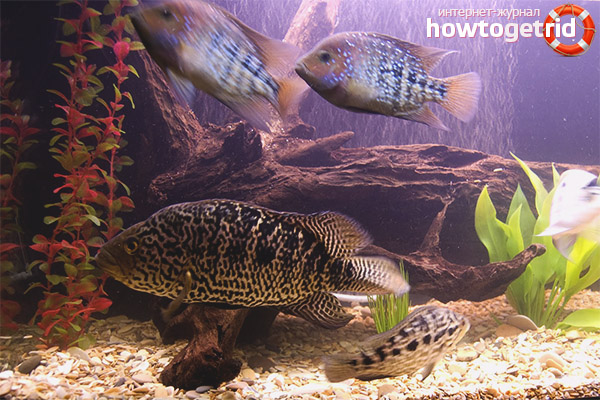The content of the article
Managuan cichlazoma is a fish, the second name of which is the jaguar cichlid. This is a fairly large and predatory representative of the cichlid family. Such fish are remembered for their bright color. However, such a bright color does not appear in the family immediately, but only upon reaching the age of puberty. In young individuals, only poorly visible stripes of black color can be found on the body, but in adult fish, spots are already showing up, due to which representatives of this family are called jaguars.
In nature, Managuan cichlomas are quite large. There are individuals with a length of up to 60 centimeters and a weight of several kilograms. However, in an aquarium such large individuals, as a rule, do not grow and reach a maximum of 40 centimeters in length. Such large sizes and natural aggressiveness give reason to keep such fish separately in the aquarium, which in its arrangement will resemble the reservoirs of Central America. Avoid sharing cichlases with other fish species smaller and less aggressive.
Life in nature
The appearance and behavior of managuan cichlazoma was first and foremost described by Gunther in 1867. The habitat of these fish is mainly Central America. You can find them near the Ulua River in Honduras to the area of the Matina River in Costa Rica. At home, the jaguar is a commercial fish, as it grows in very decent size.
Under natural conditions, the Managuan cichlazoma can exist both in lakes with soft soil and dense vegetation, and in fairly fast rivers and their tributaries. Most of all, the jaguar likes to dwell in warm water, which does not contain many oxygen molecules.
View description
The peculiarity of the representatives of this species is that throughout life such cichlomas change their color. Young individuals, both females and males, have a rather pale color, which includes dark stripes that occupy half of the body. Subsequently, as the males mature, dark spots appear. In females, only a few spots are found, which are usually concentrated in the middle of the body, right behind the gill cover. At puberty, the color becomes more similar to the color of the jaguar. It is a black and white spot, sometimes found with a blue tint.
Since Managuan cichlazomas are predators, they have pharyngeal teeth, which they use for hunting. In order to protect themselves from other predators, fish use special sharp rays on the fins.
What difficulties are encountered in the maintenance of managuan cichlases?

In general, caring for Managuan cichlases is quite simple. Perhaps the only difficulty is a large aquarium and the need for very powerful filters.Such requirements are explained by the impressive size of individuals of this species. Such a fish is not suitable for a novice aquarium pet breeder, since the representatives of cichlase are large, aggressive and predatory.
How to feed managuan cichlases?
Feeding managuan cichlases in principle is not particularly different, their diet is standard for predatory fish. In nature, such individuals feed on invertebrates and small fish. Fish in the aquarium can be fed with all types of live food, namely: tadpoles, small fish, earthworms and crickets.
In general, representatives of this family prefer to eat live food, however, they do not refuse frozen fish fillet, shrimp meat, krill and similar food. You need to feed the fish daily, just one meal is enough. Once a week you can take a break.
Many experts do not recommend often feeding fish with meat. The fact is that, for example, a beef heart contains a large amount of protein and fat. These components are very difficult to digest in the stomach of managuan cichlases. However, this does not mean that they cannot be used at all. Such foods can be added about once a week to the diet, but do not overdo it and give a lot of meat.
How to keep in the aquarium?
A very large aquarium is needed to maintain Managuan cichlids, and a volume of at least a liter is suitable. Since these fish are very aggressive, they need their own territory, which will not penetrate other individuals. Only in this way can fights and collisions be avoided. Decorative elements and gravel should also be large enough. Plants are not recommended to be used as decoration, as these healthy people will immediately tear them up with their roots and ultimately destroy them.
Under natural conditions, cichlazomas of this species live in muddy water, therefore, to bring the aquarium closer to natural conditions, you can add dry leaves to the water, oak or almond leaves are suitable.
It is very important that there is always clean water in the aquarium, however, it is quite difficult to achieve this, as individuals leave a considerable amount of waste in the process of life. To clean water from them, you need to use very powerful filters, as well as regularly change the water.
Although cichlomas can live in completely different conditions, the most optimal for them are temperatures from 24 to 28 degrees, and ph from 7 to 8.7. Specialists noted that the higher the temperature of the water in the aquarium, the more aggressive the pets become. For this reason, it is best to keep the water temperature at a lower rate, that is, 24 degrees.
Neighborhood with other individuals
If you plan to cultivate mtsihlazom, do not put them in one aquarium with catfish of the plecostomus type. At night, these individuals eat the eggs of the Managuans. In general, for a more efficient and comfortable breeding, it is better to place cichlases in a separate aquarium for spawning, where there will be no other individuals.
In one aquarium, you can keep a couple of individuals of the Managuan cichlase species. So that pets do not behave aggressively towards each other, they need to be raised together from a very young age.
Video: aquarium fish cichlazoma managuan











Submit